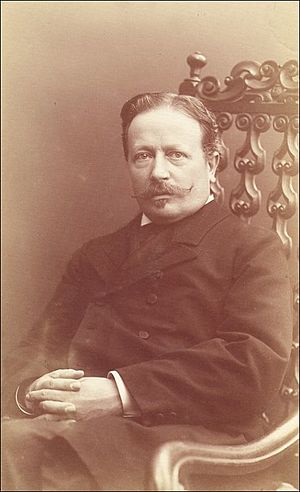Theodor Ziehen facts for kids
Georg Theodor Ziehen (born November 12, 1862 – died December 29, 1950) was an important German neurologist and psychiatrist. He was born in Frankfurt am Main, Germany. His father, Eduard Ziehen, was a well-known author.
Contents
Education and Career
When Theodor Ziehen was a student at the Lessing-Gymnasium in Frankfurt, he studied the ideas of famous thinkers like Immanuel Kant and Arthur Schopenhauer. Later, he studied medicine at the University of Würzburg and the University of Berlin. He earned his doctorate degree in 1885. While studying medicine, he also read works by other great thinkers such as David Hume, Spinoza, Plato, and George Berkeley.
After finishing his studies, Ziehen worked at a mental hospital in Görlitz. He was an assistant to Karl Ludwig Kahlbaum. In 1887, he became an assistant to Otto Binswanger at a psychiatric clinic in Jena. A famous patient of his at Jena was the philosopher Friedrich Nietzsche.
Ziehen later became a professor of psychiatry. He taught at Utrecht starting in 1900, then at the University of Halle from 1903, and finally at the University of Berlin from 1904 to 1912. In 1912, he moved to Wiesbaden and worked as a private scholar. From 1917, he was a professor of philosophy at the University of Halle. He retired in 1930 and lived in Wiesbaden until he passed away in 1950.
Important Research
Theodor Ziehen wrote almost 450 works. These included books and papers on psychology, neurology, and anatomy.
Child Psychiatry
He wrote a very important book called Die Geisteskrankheiten des Kindesalters. This means "Mental Diseases of Childhood." It was one of the first complete books about child psychiatry in Germany. He also wrote Psychiatrie für Ärzte und Studirende ("Psychiatry for Doctors and Students"). This textbook was published four times between 1894 and 1911.
Ziehen also helped create new terms in psychiatry. He introduced the words "affective psychosis" (which describes mood disorders) and "psychopathic constitution" (which refers to certain personality types).
Medical Discoveries
A medical condition is named after him and another neurologist, Hermann Oppenheim. It's called "Ziehen-Oppenheim syndrome." This is a genetic condition that causes muscle spasms, known as torsion dystonia. It happens because of a problem in a part of the brain called the basal ganglia.
Anatomy Studies
As an anatomist, Ziehen wrote very detailed descriptions of the human spinal cord, medulla oblongata, pons, and cerebellum. These are all important parts of the brain and nervous system. His work was part of a large handbook on human anatomy. He wrote about 700 pages just on the cerebellum!
He also named a part of the brain called the nucleus accumbens. He found this part while studying the brains of animals like the common ringtail possum. This was part of his research into the brains of marsupials and monotremes.
Philosophy and Psychology
In 1898, Ziehen published Psychophysiologische Erkenntnistheorie. This means "Psychophysiological Theory of Knowledge." His ideas about philosophy were based on psychology. He believed in something called associative psychology. This idea suggests that our thoughts and ideas are connected through associations.
Selected Works
Here are some of Theodor Ziehen's important books and papers:
- Leitfaden der physiologischen Psychologie (Guide to physiological psychology), 1891.
- Psychiatrie für Ärzte und Studirende (Psychiatry for doctors and students), 1894.
- Psychophysiologische Erkenntnistheorie (Psychophysiological Epistemology), 1898.
- Die Prinzipien und Methoden der Begabungs-, insbesondere der Intelligenzprüfung (Principles and methods of assessing talent, especially intelligence), 1908.
- Die Erkennung der psychopathischen Konstitutionen und die öffentliche Fürsorge für psychopatisch veranlagte Kinder (Understanding certain personality types and public care for children with these traits), 1912.
- Die Geisteskrankheiten des Kindesalters einschließlich des Schwachsinns und der psychopathischen Konstitutionen (Mental illnesses of childhood, including certain personality types), 1915-1917.
- Das Seelenleben der Jugendlichen (The inner lives of young people), 1923.
See also
 In Spanish: Theodor Ziehen para niños
In Spanish: Theodor Ziehen para niños


